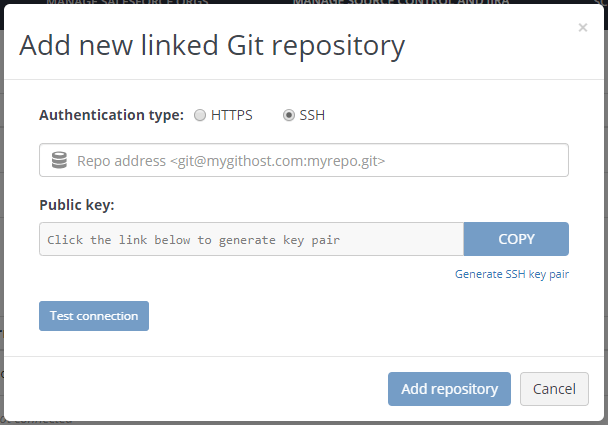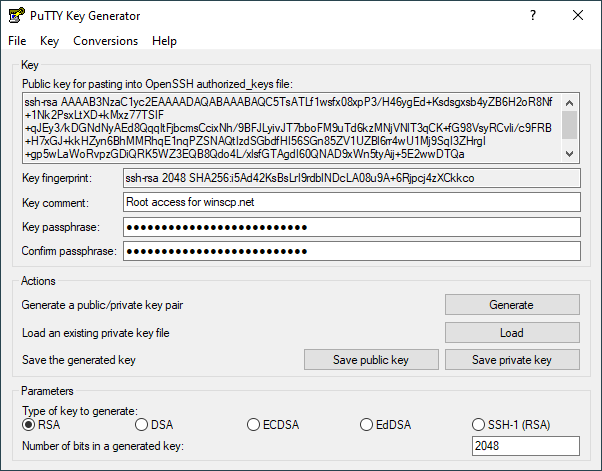Generate New Ssh Key Pair
To generate the public/private key pair, enter this in the Command Prompt: ssh-keygen At the first prompt, “Enter file in which to save the key,” press Enter to save it in the default location. Generating a new SSH key pair To generate a new SSH key pair, use the following command: Git Bash on Windows / GNU/Linux / macOS: ssh-keygen -t rsa -C 'your.email@example.com'-b 4096 Windows: Alternatively on Windows you can download PuttyGen and follow this documentation article to generate a SSH key pair. Create and add your SSH key pair. It is best practice to use Git over SSH instead of Git over HTTP. In order to use SSH, you will need to: Create an SSH key pair; Add your SSH public key to GitLab. Creating your SSH key pair. Go to your command line. Follow the instructions to generate your SSH key pair. Adding your SSH public key to GitLab.
Introduction
SSH (Secure Shell) allows secure remote connections between two systems. With this cryptographic protocol, you can manage machines, copy, or move files on a remote server via encrypted channels.
There are two ways to login onto a remote system over SSH – using password authentication or public key authentication (passwordless SSH login).
In this tutorial, you will find out how to set up and enable passwordless SSH login.
- Access to command line/terminal window
- User with sudo or root privileges
- A local server and a remote server
- SSH access to a remote server via command line/terminal window
Game maker license key generator. You may already have an SSH key pair generated on your machine. To see whether you have SSH keys on the system, run the command:
If the output tells you there are no such files, move on to the next step, which shows you how to generate SSH keys.
In case you do have them, you can use the existing keys, back them up and create a new pair or overwrite it.
1. The first thing you need to do is generate an SSH key pair on the machine you are currently working on.
In this example, we generate a 4096-bit key pair. We also add an email address, however this is optional. The command is:
2. Next, type in the location where you want to store the keys or hit Enter to accept the default path.
3. It also asks you to set a passphrase. Although this makes the connection even more secure, it may interrupt when setting up automated processes. Therefore, you can type in a passphrase or just press Enter to skip this step.
4. The output then tells you where it stored the identification and public key and gives you the key fingerprint.
5. Verify you have successfully created the SSH key pair by running the command:
You should see the path of the identification key and the public key, as in the image below:
Generate Ssh Key Pair Mac
You can upload the public SSH key to a remote server with the ssh-copy-id command or the cat command. Below you can find both options.
Option 1: Upload Public Key Using the ssh-copy-id Command
To enable passwordless access, you need to upload a copy of the public key to the remote server.
1. Connect to the remote server and use the ssh-copy-id command:
2. The public key is then automatically copied into the .ssh/authorized_keys file.
Another way to copy the public key to the server is by using the cat command.
1. Start by connecting to the server and creating a .ssh directory on it.
2. Then, type in the password for the remote user.
3. Now you can upload the public key from the local machine to the remote server. The command also specifies that the key will be stored under the name authorized_keys in the newly created .ssh directory:
With the SSH key pair generated and the public key uploaded to the remote server, you should now be able to connect to your dedicated server without providing a password.
Check whether the setup works by running the command:
The system should directly log you in to the remote server, no password required.
Note: Once you verify that you can SHH into the remote serve without a password, consider disabling SSH password authentication altogether. It will add another layer of security and secure your server from brute-force attacks.
Optional: Troubleshooting Remote Server File Permissions
File permissions on the remote server may cause issues with passwordless SSH login. This is a common issue with older versions of SSH.
sony vaio svf142c29l drivers If you are still prompted for a password after going through all the steps, start by editing file permissions on the remote server.
- Set permissions 700 for the .ssh directory.
- Set permissions 640 for the .ssh/authorized_keys directory.
Edit file permissions with the following command:
Enter your password when prompted. There will be no output if the action was successful. The issue should be resolved now.

If you want to automate updates and other tasks, or seamlessly SSH into a remote server, you should enable passwordless SSH login.
The instructions outlined in this article should have helped you to do so.
For more SSH commands, check out these 19 common SSH commands in Linux with examples.
Next you should also read
When establishing a remote connection between a client and a server, a primary concern is ensuring a secure…

Hackers are always on the lookout for server vulnerabilities. Minimize risks and be confident your data is…
The article covers the 5 most common and efficient ways to secure an SSH connection. The listed solutions go…
Rsync is a Linux tool that allows you to transfer data over SSH to a remote server securely. Use the options…
-->With a secure shell (SSH) key pair, you can create virtual machines (VMs) in Azure that use SSH keys for authentication, eliminating the need for passwords to sign in. This article shows you how to quickly generate and use an SSH public-private key file pair for Linux VMs. You can complete these steps with the Azure Cloud Shell, a macOS or Linux host, the Windows Subsystem for Linux, and other tools that support OpenSSH.
Note
VMs created using SSH keys are by default configured with passwords disabled, which greatly increases the difficulty of brute-force guessing attacks.
For more background and examples, see Detailed steps to create SSH key pairs.
For additional ways to generate and use SSH keys on a Windows computer, see How to use SSH keys with Windows on Azure.
Supported SSH key formats
Azure currently supports SSH protocol 2 (SSH-2) RSA public-private key pairs with a minimum length of 2048 bits. Other key formats such as ED25519 and ECDSA are not supported.
Create an SSH key pair
Use the ssh-keygen command to generate SSH public and private key files. By default, these files are created in the ~/.ssh directory. You can specify a different location, and an optional password (passphrase) to access the private key file. If an SSH key pair with the same name exists in the given location, those files are overwritten.
The following command creates an SSH key pair using RSA encryption and a bit length of 4096:
If you use the Azure CLI to create your VM with the az vm create command, you can optionally generate SSH public and private key files using the --generate-ssh-keys option. The key files are stored in the ~/.ssh directory unless specified otherwise with the --ssh-dest-key-path option. The --generate-ssh-keys option will not overwrite existing key files, instead returning an error. In the following command, replace VMname and RGname with your own values:
Provide an SSH public key when deploying a VM
To create a Linux VM that uses SSH keys for authentication, specify your SSH public key when creating the VM using the Azure portal, Azure CLI, Azure Resource Manager templates, or other methods:
Ssh Generate Private Key
If you're not familiar with the format of an SSH public key, you can display your public key with the following cat command, replacing ~/.ssh/id_rsa.pub with the path and filename of your own public key file if needed:
A typical public key value looks like this example:
If you copy and paste the contents of the public key file to use in the Azure portal or a Resource Manager template, make sure you don't copy any trailing whitespace. To copy a public key in macOS, you can pipe the public key file to pbcopy. Similarly in Linux, you can pipe the public key file to programs such as xclip.
The public key that you place on your Linux VM in Azure is by default stored in ~/.ssh/id_rsa.pub, unless you specified a different location when you created the key pair. To use the Azure CLI 2.0 to create your VM with an existing public key, specify the value and optionally the location of this public key using the az vm create command with the --ssh-key-values option. In the following command, replace VMname, RGname, and keyFile with your own values:
If you want to use multiple SSH keys with your VM, you can enter them in a space-separated list, like this --ssh-key-values sshkey-desktop.pub sshkey-laptop.pub.
SSH into your VM
Ssh Key Generation
With the public key deployed on your Azure VM, and the private key on your local system, SSH into your VM using the IP address or DNS name of your VM. In the following command, replace azureuser and myvm.westus.cloudapp.azure.com with the administrator user name and the fully qualified domain name (or IP address):
If you specified a passphrase when you created your key pair, enter that passphrase when prompted during the login process. The VM is added to your ~/.ssh/known_hosts file, and you won't be asked to connect again until either the public key on your Azure VM changes or the server name is removed from ~/.ssh/known_hosts.
Generate New Ssh Key Wsl
If the VM is using the just-in-time access policy, you need to request access before you can connect to the VM. For more information about the just-in-time policy, see Manage virtual machine access using the just in time policy.
Next steps
For more information on working with SSH key pairs, see Detailed steps to create and manage SSH key pairs.
If you have difficulties with SSH connections to Azure VMs, see Troubleshoot SSH connections to an Azure Linux VM.